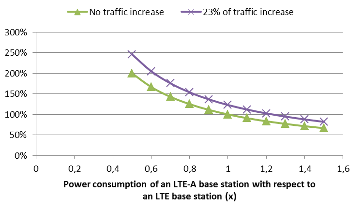




read more











In the future, the authors would like to consider the following perspectives. Further investigations will tackle the case of mobile networks that do not fit this linearity condition. First, it is worth to note that the numerical applications contained in this paper are limited to a mobile network whose capacity is a linear function in the number of radio sites, or which can be approximated as such. It may be worthy to investigate the impact of other network topologies, for instance a Heterogeneous Network ( HetNet ) comprising micro sites, as well as the impact of their model on the QoS performance of the network.
However when an LTE-A site consumes more power, i.e., x > 1, the only way to preserve the energy efficiency of the network is when θ = 1, i.e., when the network is not upgraded.
The network the authors investigated has an uplink-energy-per-bit of 200 µJ/bit, i.e., the uplink radio resources consume on average 200 µJ per transmitted bit.
The study of the sign of the derivative of the energy-per-bit shows that when an LTE-A site does not consume more power than an LTE site, the swap operation increases the capacity of the network without deteriorating its energy efficiency.
The authors showed that when the new technology decreases the idle power component of the network, a network upgrade can always improve or at least keep the energy efficiency of the network.
If an LTE-A site consumes more power than an LTE site, the study of the sign of the derivative of the energy-per-bit shows that the swap operation increases the network’s capacity but decreases its energy efficiency, although an LTE-A site is more energy-efficient than an LTE site at full operating load.
For instance, in the case where an LTE-A site consumes 0.4 more energy than an LTE site, i.e., x = 1.4, the operator should keep at least 40% of LTE sites in the upgraded network, given 23% of traffic increase.
In addition, the authors showed that a network loaded even at only half of its capacity allows significant energy savings, on the order of 95% for a photo upload on Facebook, for the network considered in this work.
The energy-per-bit of the network is (after simplification of Eqn. (7)),α(R,K) = P bsmax − P bs 0Cbs + P bs0K R (11)Eqn. (11) shows that the energy efficiency of the network (inverse of the energy-per-bit) is proportional to the traffic and inversely proportional to the number of sites.
When the parabola opens downward, i.e., when the new technology decreases the idle power of the network, there is no limit value of K beyond which the derivative of the energy-perbit is always positive, this means that it is always possible to upgrade the network while preserving its energy efficiencywhen the new technology decreases the network’s idle power.
it is more spectral and energy efficient to densify the network with indoor small cells mainly, while maintaining some outdoor coverage for high-speed outdoor users.
it is worth to note that the numerical applications contained in this paper are limited to a mobile network whose capacity is a linear function in the number of radio sites, or which can be approximated as such.
using the network even only at half of its capacity allows significant energy savings, unlike the actual operation of networks which are most of the time under-loaded, about 10% on average for the investigated network.
Fig. 4 shows the energy efficiency (inverse of the energyper-bit) of the upgraded network (LTE-A network), as a function of x, the power consumption ratio of an LTE-A site versus an LTE site.
Fig. 4 shows the energy efficiency (inverse of the energyper-bit) of the upgraded network (LTE-A network), as a function of x, the power consumption ratio of an LTE-A site versus an LTE site.
The authors note clearly that the LTE-A technology degrades the energy performance of the network when an LTE-A site consumes more power than an LTE site, since the LTEA network’s energy efficiency is lower than the LTE network’s energy efficiency for x > 1.2) Replacing LTE sites by a different number of LTEA sites:
By resolving the inequality α(Rf ,Kf ) ≤ α(Ri,Ki), i.e., the energy-per-bit of the upgraded network should be lower than or equal to the energy-per-bit of the initial network, the authors get:(1− x)(1− y)KfC bsP bs0zRi θ2 + ((( xKf z −Ki) 1− y Ri+ (1− x)yKfzRi )CbsP bs0 + (y − x)(P bs max − P bs 0 ))θ+ (( xKf z −Ki) yCbsP bs0 Ri + (x− y)(P bsmax − P bs 0 )) ≤ 0(16)where θ is the proportion of LTE sites in the upgraded network.
The authors considered two techniques for network upgrade: either by adding sites with the same technology or by adding sites implementing another technology, typically more recent and more efficient.
This result is also logical since replacing an LTE site by a more energy-consuming LTE-A site at constant traffic can only degrade the network’s energy efficiency.